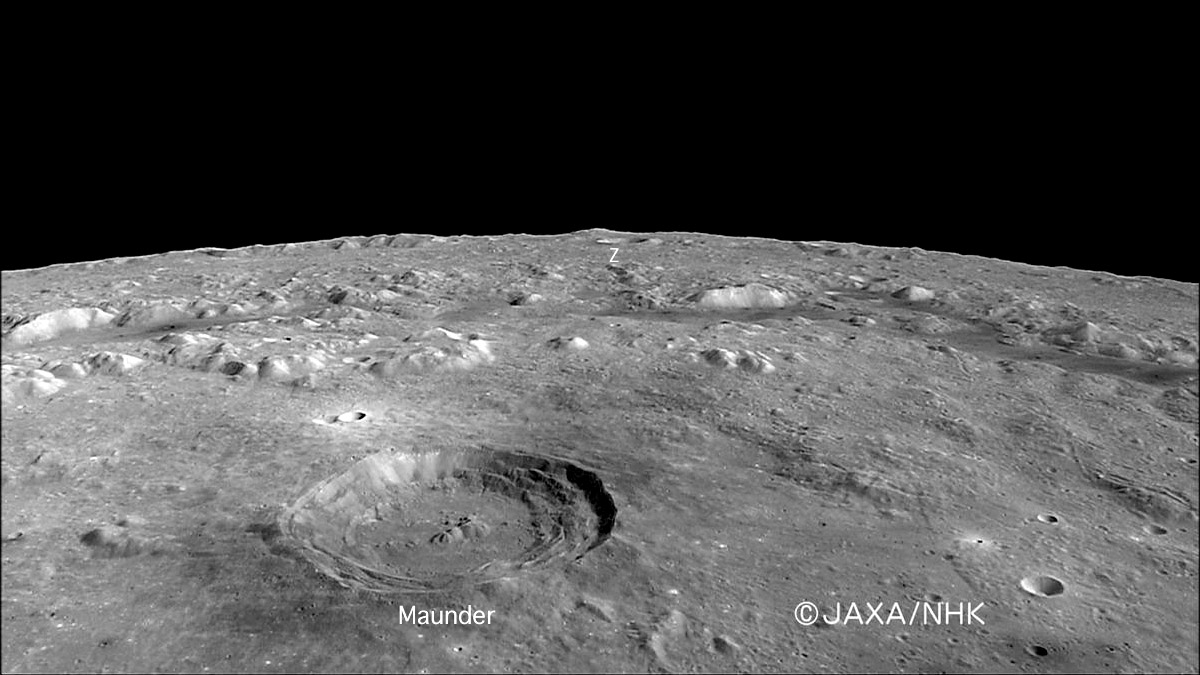Difference between revisions of "LPOD Feb 14, 2008"
(Created page with "<div id="content_view" class="wiki" style="display: block"> =ROOKS, BUT NOT ROOKED= <br /> LPOD-Feb14-08.jpg<br /> ''image from [http://wms.selen...") |
|||
| (2 intermediate revisions by the same user not shown) | |||
| Line 1: | Line 1: | ||
<div id="content_view" class="wiki" style="display: block"> | <div id="content_view" class="wiki" style="display: block"> | ||
=ROOKS, BUT NOT ROOKED= | =ROOKS, BUT NOT ROOKED= | ||
| − | <br /> [[Image:LPOD-Feb14-08.jpg|LPOD-Feb14-08.jpg]]<br /> ''image from [http://wms.selene.jaxa.jp/index_e.html Kaguya Image Gallery]''<br /> <br /> Except for handheld Hasselblad photos, most images from lunar orbit look straight down on the lunar surface. But the high definition TV camera on Kaguya gives the oblique view that some younger visitors to LPOD may hope to see themselves someday. In this recently released still from a HDTV video we are over the northern third of the [ | + | <br /> [[Image:LPOD-Feb14-08.jpg|LPOD-Feb14-08.jpg]]<br /> ''image from [http://wms.selene.jaxa.jp/index_e.html Kaguya Image Gallery]''<br /> <br /> Except for handheld Hasselblad photos, most images from lunar orbit look straight down on the lunar surface. But the high definition TV camera on Kaguya gives the oblique view that some younger visitors to LPOD may hope to see themselves someday. In this recently released still from a HDTV video we are over the northern third of the [[Mare%20Orientale|Orientale]] impact basin. Maunder is seen to be a very fresh crater with steeply-dipping terraces, relatively small central peaks and possible impact melt splayed on the surface to the right and left (dark coating). The narrow ribbon of mare lava - [[Lacus%20Veris|Lacus Veris]] - near the middle of the image is just along the inner edge of the Outer [[Montes%20Rook|Rook Mountains]], and the peaks this side of the lacus help define the Inner Rook Mountains. The puffy, rounded looking, fractured material is the US Geologic Survey-named Maunder Formation. It is interpreted to be Orientale Basin impact melt, a larger scale version of the material on the floor of Tycho. The Cordillera Mountains are on the limb and the area between there and the Outer Rook is thought to be ejecta from the impact that formed the Orientale Basin. If this so-called Rook Formation is ejecta then the Outer Rook is the rim of Orientale, not the Cordillera Mountains. This interpretation is generally accepted but seems counter-intuitive because of the massive scarp of the Cordillera. Two massive peaks of the Outer Rook occur at the 1 o'clock and 11 o'clock positions from the Maunder crater. These wonderful massifs deserve names. Finally, notice the dark halo impact craters that penetrate light dusting and bring up dark debris on to the surface of Lacus Veris.<br /> <br /> ''Chuck Wood''<br /> <br /> '''Related Links'''<br /> ''Clementine Atlas'' plate 90 <br /> <br /> '''[[LPOD%20Index|Index]] of past LPOD's'''<br /> <br /> <br /> <br /> </div> |
Latest revision as of 13:38, 15 April 2018
ROOKS, BUT NOT ROOKED

image from Kaguya Image Gallery
Except for handheld Hasselblad photos, most images from lunar orbit look straight down on the lunar surface. But the high definition TV camera on Kaguya gives the oblique view that some younger visitors to LPOD may hope to see themselves someday. In this recently released still from a HDTV video we are over the northern third of the Orientale impact basin. Maunder is seen to be a very fresh crater with steeply-dipping terraces, relatively small central peaks and possible impact melt splayed on the surface to the right and left (dark coating). The narrow ribbon of mare lava - Lacus Veris - near the middle of the image is just along the inner edge of the Outer Rook Mountains, and the peaks this side of the lacus help define the Inner Rook Mountains. The puffy, rounded looking, fractured material is the US Geologic Survey-named Maunder Formation. It is interpreted to be Orientale Basin impact melt, a larger scale version of the material on the floor of Tycho. The Cordillera Mountains are on the limb and the area between there and the Outer Rook is thought to be ejecta from the impact that formed the Orientale Basin. If this so-called Rook Formation is ejecta then the Outer Rook is the rim of Orientale, not the Cordillera Mountains. This interpretation is generally accepted but seems counter-intuitive because of the massive scarp of the Cordillera. Two massive peaks of the Outer Rook occur at the 1 o'clock and 11 o'clock positions from the Maunder crater. These wonderful massifs deserve names. Finally, notice the dark halo impact craters that penetrate light dusting and bring up dark debris on to the surface of Lacus Veris.
Chuck Wood
Related Links
Clementine Atlas plate 90
Index of past LPOD's